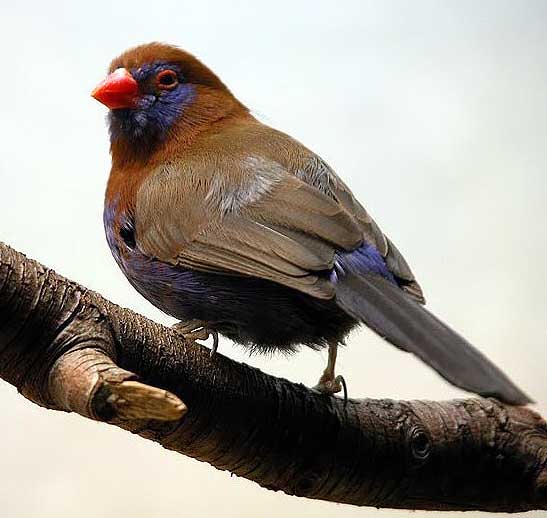
Uraeginthus ianthinogaster(*)
Superregnum: Eukaryota
Regnum: Animalia
Subregnum: Eumetazoa
Cladus: Bilateria
Cladus: Nephrozoa
Superphylum: Deuterostomia
Phylum: Chordata
Cladus: Craniata
Subphylum: Vertebrata
Infraphylum: Gnathostomata
Superclassis: Tetrapoda
Cladus: Reptiliomorpha
Cladus: Amniota
Classis: Reptilia
Cladus: Eureptilia
Cladus: Romeriida
Subclassis: Diapsida
Cladus: Sauria
Infraclassis: Archosauromorpha
Cladus: Crurotarsi
Divisio: Archosauria
Subsectio: Ornithodira
Subtaxon: Dinosauromorpha
Cladus: Dinosauria
Ordo: Saurischia
Cladus: Eusaurischia
Cladus: Theropoda
Cladus: Neotheropoda
Infraclassis: Aves
Ordo: Passeriformes
Subordo: Passeri
Infraordo: Passerida
Superfamilia: Passeroidea
Familia: Estrildidae
Genus: Uraeginthus
Species: Uraeginthus ianthinogaster
Subspecies: U. i. hawkeri – U. i. ianthinogaster – U. i. roosevelti – U. i. rothschildi – U. i. ugandae
Name
Uraeginthus ianthinogaster Reichenow, 1879
References
Ornithologisches Centralblatt 4 p. 114
Vernacular names
čeština: motýlek modrobřichý
Cymraeg: Grenadwr porffor
Deutsch: Veilchenastrild
English: Purple grenadier
suomi: Kobolttipeippo
français: Cordonbleu violacé
magyar: Bíbormellű pillangópinty, kékhasú gránátpinty
日本語: ムラサキトキワスズメ
Nederlands: Blauwbuikgranaatastrild
norsk: Purpurastrild
svenska: Violastrild
中文: 紫蓝饰雀
The purple grenadier (Granatina ianthinogaster) is a common species of estrildid finch found in eastern Africa.
Description
The length averages 13.3 cm (5.25 in). All ages and sexes have a black tail, and adults have a red bill. The male has a cinnamon-colored head and neck with a blue patch surrounding the eye. The rump is purplish blue and the underparts are violet-blue with variable rufous patches. The female is smaller and mostly cinnamon brown with white barring on the underparts and silver-blue eyepatches. Juveniles are like females, but mostly unbarred tawny-brown with a reddish-brown bill.[2]
The song (in Kenya) is described as "a high, thin chit-cheet tsereea-ee-ee tsit-tsit, or cheerer cheet tsee-tsee sur-chit."[2]
The phylogeny has been obtained by Antonio Arnaiz-Villena et al.Arnaiz-Villena, A.; Ruiz V.; González C. (1999). "Los Azulitos Africanos" (PDF). Revista Pájaros. 35.</ref>
Range and habitat
It is found in subtropical and tropical (lowland) dry shrubland in Ethiopia, Kenya, Somalia, South Sudan, Tanzania and Uganda, an estimated global extent of occurrence of 1,500,000 km2. The status of the species is evaluated as Least Concern.[3]
Origin
Origin and phylogeny has been obtained by Antonio Arnaiz-Villena et al.[4] Estrildinae may have originated in India and dispersed thereafter (towards Africa and Pacific Ocean habitats).
References
BirdLife International (2016). "Granatina ianthinogaster". IUCN Red List of Threatened Species. 2016: e.T22719504A94630724. doi:10.2305/IUCN.UK.2016-3.RLTS.T22719504A94630724.en. Retrieved 12 November 2021.
Zimmerman, Dale A.; Turner, Donald A.; Pearson, David J. (1999). Birds of Kenya and Northern Tanzania. Princeton University Press. pp. 254–255, 553. ISBN 978-0-691-01022-9.
BirdLife International (2004). "Uraeginthus ianthinogaster". IUCN Red List of Threatened Species. 2004. Retrieved 7 June 2007. .
Arnaiz-Villena, A; Ruiz-del-Valle V; Gomez-Prieto P; Reguera R; Parga-Lozano C; Serrano-Vela I (2009). "Estrildinae Finches (Aves, Passeriformes) from Africa, South Asia and Australia: a Molecular Phylogeographic Study" (PDF). The Open Ornithology Journal. 2: 29–36. doi:10.2174/1874453200902010029.
Retrieved from "http://en.wikipedia.org/"
All text is available under the terms of the GNU Free Documentation License

